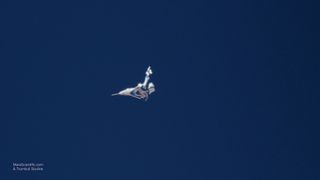Watch This Awesome Uncut Video of Virgin Galactic's VSS Unity Test Flight!
When Virgin Galactic sends its SpaceShipTwo spaceliner on a test flight, it's a pretty safe bet to expect a polished video recap of the mission. And that's exactly what the private spaceflight company did this week after a successful rocket-powered test flight Tuesday (May 29).
But here's something different: an uncut video of Virgin Galactic's SpaceShipTwo VSS Unity as it lights its rocket motor, streaks upward and deploys its novel feathering system to begin the glide back to Earth.
The 3-minute-and-14-second video, which Virgin Galactic released Wednesday (May 30), offers the best glimpse yet at what passengers will experience when they pay $250,000 for a trip to space on SpaceShipTwo. You can clearly see the spacecraft's rocket motor fire as Unity soars straight up into the sky. The space plane then coasts upward (with the pilots experiencing a period of weightlessness inside) and then fires reaction control thrusters in its nose to pitch the front down for the trip back to Earth. [See more photos of Unity's second powered test flight]
Unity's pilots (Dave Mackay and Mark "Forger" Stucky) then activated the space plane's "feathering" system, which tips the vehicle's twin tail booms up to slow down and maintain stability for the descent back to Earth.

Virgin Galactic's SpaceShipTwo Unity is designed to fly six paying passengers and two pilots to suborbital space (it won't orbit Earth) and back for $250,000 a ticket. The space plane is carried into launch position by the VMS Eve, a massive mother ship.
To be clear, Virgin Galactic didn't reach space during Tuesday's test flight, which marked the second rocket-powered flight for the Unity spacecraft. The first occurred on April 5.
Get the Space.com Newsletter
Breaking space news, the latest updates on rocket launches, skywatching events and more!
"It was great to see our beautiful spaceship back in the air so soon after her last flight and to share the moment with the talented team who are taking us, step by step, to space," Virgin Galactic's billionaire founder, Sir Richard Branson, said in a statement after the flight. "We saw VSS Unity in her natural environment, flying fast under rocket power and with a nose pointing firmly towards the black sky of space."
The flight took off from the Mojave Air and Space Port in California, and the VMS Eve dropped Unity from an altitude of 50,000 feet (15,000 meters). Unity's rocket motor fired for 31 seconds, sending the space plane to an altitude of 114,500 feet (34,900 m), Virgin Galactic representatives said. The spacecraft went supersonic, reaching a max speed of Mach 1.9.
Tuesday's mission marked the 13th test flight for Unity, Virgin Galactic's second SpaceShipTwo vehicle. The first, called VSS Enterprise, broke apart during a powered test flight in 2014 in an accident that killed co-pilot Michael Alsbury and seriously injured pilot Peter Siebold.
Investigators determined that Alsbury deployed the "feathering" system too early in the flight. Virgin Galactic modified Unity's design to prevent that from happening again.
Email Tariq Malik at tmalik@space.com or follow him @tariqjmalik. Follow us @Spacedotcom, Facebook and Google+. Original article on Space.com
Join our Space Forums to keep talking space on the latest missions, night sky and more! And if you have a news tip, correction or comment, let us know at: community@space.com.

Tariq is the Editor-in-Chief of Space.com and joined the team in 2001, first as an intern and staff writer, and later as an editor. He covers human spaceflight, exploration and space science, as well as skywatching and entertainment. He became Space.com's Managing Editor in 2009 and Editor-in-Chief in 2019. Before joining Space.com, Tariq was a staff reporter for The Los Angeles Times covering education and city beats in La Habra, Fullerton and Huntington Beach. In October 2022, Tariq received the Harry Kolcum Award for excellence in space reporting from the National Space Club Florida Committee. He is also an Eagle Scout (yes, he has the Space Exploration merit badge) and went to Space Camp four times as a kid and a fifth time as an adult. He has journalism degrees from the University of Southern California and New York University. You can find Tariq at Space.com and as the co-host to the This Week In Space podcast with space historian Rod Pyle on the TWiT network. To see his latest project, you can follow Tariq on Twitter @tariqjmalik.
